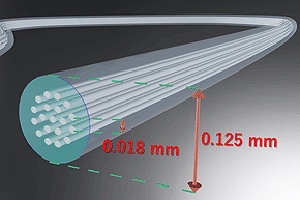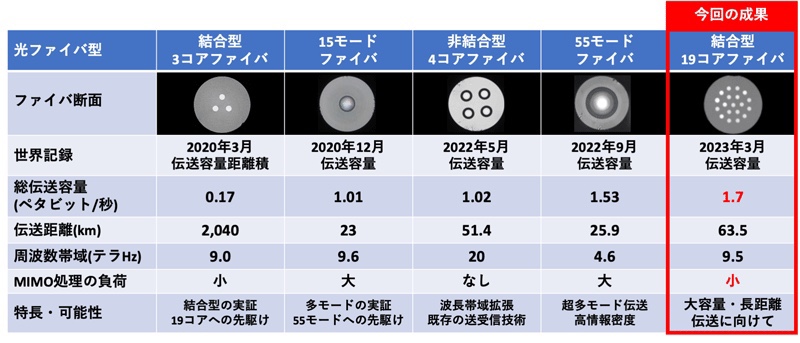

Multi-core optical fiber: Successful transmission of 1.7 petabits!
– SUMITOMO ELECTRIC TECHNICAL REVIEW Contributors’ Voice –
National Institute of Information and Communications Technology
Sumitomo Electric Industries
March 15th,
“Multi-core optical fiber with 19 cores”
It succeeded in “transmitting 1.7 petabits per second (peta is 1,000 trillion).”
Important technologies after 6G:
– New world record for standard outer diameter multi-core optical fiber –
It will be of major importance after the 6th generation communication (6G).
Multi-core optical fiber:
Nineteen cores were formed “inside an optical fiber with a thickness of 0.125 mm.”
Since “optical signals are sent to each core and multiplexed”, there was “a problem of signal interference between cores”.
Reject interfering signals:
– This time, we devised how to arrange the cores –
Inter-core interference was randomized to homogenize the propagation characteristics.
As a result, we were able to reduce the “time difference between signals arriving at each core”.
If this time difference is shortened, the “load of digital signal processing for removing interference signals” can be reduced.
Digital signal processing load:
– 1.7 petabits per second for a transmission distance of 63.5 km –
We were able to process the signal with “a load that is several hundredths of that of the conventional technology.”
The 10,000 km required for a submarine cable can be reduced to a few thousandths.
−newswitch
Developed the world’s first standard outer diameter 19-core optical fiber and broke the world record for transmission capacity | 2023 | NICT
https://www.nict.go.jp/press/2023/03/15-1.html
(PDF) Randomly-Coupled Multi-Core Fiber Technology
https://www.researchgate.net/publication/361477053_Randomly-Coupled_Multi-Core_Fiber_Technology
Fibre optique multicœur : Transmission réussie de 1,7 pétabits !
– SUMITOMO ELECTRIC TECHNICAL REVIEW Voix des contributeurs –
Institut national des technologies de l’information et de la communication
Industries électriques Sumitomo
15 mars,
“Fibre optique multicœur à 19 cœurs”
Il a réussi à “transmettre 1,7 pétabits par seconde (peta = 1 000 billions)”.
Technologies importantes après la 6G :
– Nouveau record mondial pour la fibre optique multicœur de diamètre extérieur standard –
Il sera d’une importance majeure après la communication de 6ème génération (6G).
Fibre optique multicœur :
Dix-neuf cœurs ont été formés “à l’intérieur d’une fibre optique d’une épaisseur de 0,125 mm”.
Étant donné que “les signaux optiques sont envoyés à chaque cœur et multiplexés”, il y avait “un problème d’interférence de signal entre les cœurs”.
Rejeter les signaux parasites :
– Cette fois, nous avons imaginé comment disposer les noyaux –
L’interférence inter-cœur a été randomisée pour homogénéiser les caractéristiques de propagation.
En conséquence, nous avons pu réduire la “différence de temps entre les signaux arrivant à chaque cœur”.
Si cette différence de temps est raccourcie, la “charge de traitement de signal numérique pour éliminer les signaux d’interférence” peut être réduite.
Charge de traitement du signal numérique :
– 1,7 pétabits par seconde pour une distance de transmission de 63,5 km –
Nous avons pu traiter le signal avec “une charge plusieurs centièmes de celle de la technologie conventionnelle”.
Les 10 000 km requis pour un câble sous-marin peuvent être réduits à quelques millièmes.
−commutateur de nouvelles
A développé la première fibre optique à 19 cœurs de diamètre extérieur standard au monde et a battu le record mondial de capacité de transmission | 2023 | NTIC
Multicore-Glasfaser: Erfolgreiche Übertragung von 1,7 Petabit!
– SUMITOMO ELECTRIC TECHNICAL REVIEW Meinung der Mitwirkenden –
Nationales Institut für Informations- und Kommunikationstechnologie
Sumitomo Electric Industries
15. März,
“Mehrkern-Glasfaser mit 19 Adern”
Es gelang ihm, „1,7 Petabit pro Sekunde zu übertragen (Peta sind 1.000 Billionen).“
Wichtige Technologien nach 6G:
– Neuer Weltrekord für Mehrkern-Glasfaser mit Standard-Außendurchmesser –
Sie wird nach der Kommunikation der 6. Generation (6G) von großer Bedeutung sein.
Mehradrige Glasfaser:
Neunzehn Kerne wurden “innerhalb einer optischen Faser mit einer Dicke von 0,125 mm” gebildet.
Da „optische Signale an jeden Kern gesendet und gemultiplext werden“, gebe es „ein Problem der Signalinterferenz zwischen den Kernen“.
Störsignale unterdrücken:
– Diesmal haben wir uns überlegt, wie man die Kerne anordnet –
Inter-Core-Interferenz wurde randomisiert, um die Ausbreitungseigenschaften zu homogenisieren.
Dadurch konnten wir den „Zeitunterschied zwischen den an jedem Kern ankommenden Signalen“ reduzieren.
Wird diese Zeitdifferenz verkürzt, kann die „Belastung der digitalen Signalverarbeitung zum Entfernen von Störsignalen“ reduziert werden.
Belastung der digitalen Signalverarbeitung:
– 1,7 Petabit pro Sekunde bei einer Übertragungsdistanz von 63,5 km –
Wir konnten das Signal mit „einer Belastung, die mehrere Hundertstel der konventionellen Technik beträgt“, verarbeiten.
Die für ein Seekabel benötigten 10.000 km lassen sich auf wenige Tausendstel reduzieren.
−neuerSchalter
Entwicklung der weltweit ersten 19-Kern-Glasfaser mit Standardaußendurchmesser und gebrochener Weltrekord für Übertragungskapazität | 2023 | NICT